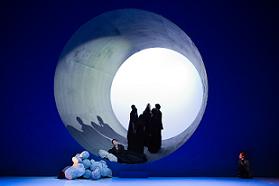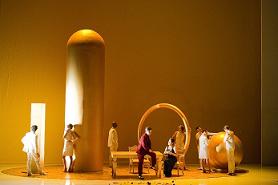Classical Mozart? Is the Master from Salzburg outdated? The message of “Lucio Silla,” an opera composed at the age of sixteen, remains universally political. And completely utopian, as the Austrian composer himself reportedly joked: has anyone ever seen a fierce dictator spontaneously give up power? A loose adaptation of a bloody episode of the Roman Empire reported by the historian Tacitus, Mozart’s work contains all the elements of an “opera seria”: the political gestation of a betrayal coupled with a sentimental drama. And a necessary “Lieto fine,” a unifying “happy end” whose philosophy must celebrate the high virtues of the human soul.
Thus, we applaud the excellent work of the Opéra de Nice for the premiere on Friday, February 19, of this “Lucio Silla”: the team from all corners of Europe deliberately focused on an interpretation based on savvy doses: a modernity without excess and a dynamic staging by Dieter Kaegi, fluid yet respectful in its scenography of the dramaturgical intensity for the most moving passages. The same goes for the costumes chosen by Bruno Schwengl: outfits that are both simple and able to enhance, if not illuminate without blinding, the characters’ temperaments. Special mention must also be given to the dancers of Ballet Nice Méditerranée and the choreography of Liz Roche: their presence, their slow and meticulous evolutions in the shadows of the artists have greatly heightened the sensual tension and enriched the lyrical power of the libretto.
In this work, the distribution of voices remains a thorny issue: “Lucio Silla” indeed combines the register of two tenors (Lucio Silla, the dictator, and Aufidio, his accomplice), three sopranos (Giunia, the imprisoned wife, Celia, the tyrant’s sister, and Cinna, the hero’s friend in exile) while the character of Cecilio, the Roman senator in exile, was, at the time, reserved for a castrato. Let’s move on to the titular role of Lucio Silla, interpreted at short notice by tenor Matthias Klink in replacement of Bruce Ford, whose poor performance thereby benefits from some extenuating circumstances. A paradox of this work since Mozart removed from this main character two of the four arias originally written for him. His accomplice Aufidio played by the Korean Min Seok Kim fares significantly better even though the vocal demands of the character are more limited.
In the role of Giunia, soprano Daniela Bruera unfortunately makes us wait too long until the third act: she literally charms the audience in her grand aria “Fra i pensier piu funesti di morte” where her voice finally sheds the recurring dryness that makes it particularly unpleasant in the high notes of the first two acts. An immense regret for the music lover who otherwise appreciates her vocal range and the qualities of her dramatic performance. Well known to the Nice public for her magnificent interpretation of Eurydice in April 2009 and that of Agilea in “Teseo” in March 2007, soprano Brigitte Hool retains intact the quality of her high notes even if this role does not seem to give her the opportunity to showcase the full extent of her art. Let’s save, if we dare say, the best for last: Christine Knorren forms an unforgettable vocal duo with Eleonore Marguerre. The former moves with a stable, full, and warm contralto voice capable of seamlessly linking harmonious vocalizes and more intimate singing without ever leaving the register of intense emotion. Very comfortable in her stage presence, the German mezzo-soprano is equally adept at the balanced exploitation of her vocal spectrum. One could not help but applaud her interpretation in Act I of “Il tenero momento” as well as the Andante and accompanied recitative “Morte, Morte fatal.” This is followed by the superb intervention of the Nice Opera Choirs in “Fuor di queste urne dolenti” whose dark accents foreshadow the finale of the future “Don Giovanni.” The response given by the soprano from Heidelberg is in tune: with a voice of clear and pleasant tones in the high notes, Eleonore Marguerre convincingly contributes to the dramatic tissue of this Niçois “Lucio Silla.”
Musical direction by Guido Rumstadt fortunately feels the special sensitivity of this Mozartian score. Under his baton, the Regional Orchestra of Cannes Provence Alpes Côte d’Azur rises to the challenge of music much more elaborate than it appears to the listener. Mozart, even as a teenager, remains Mozart.





